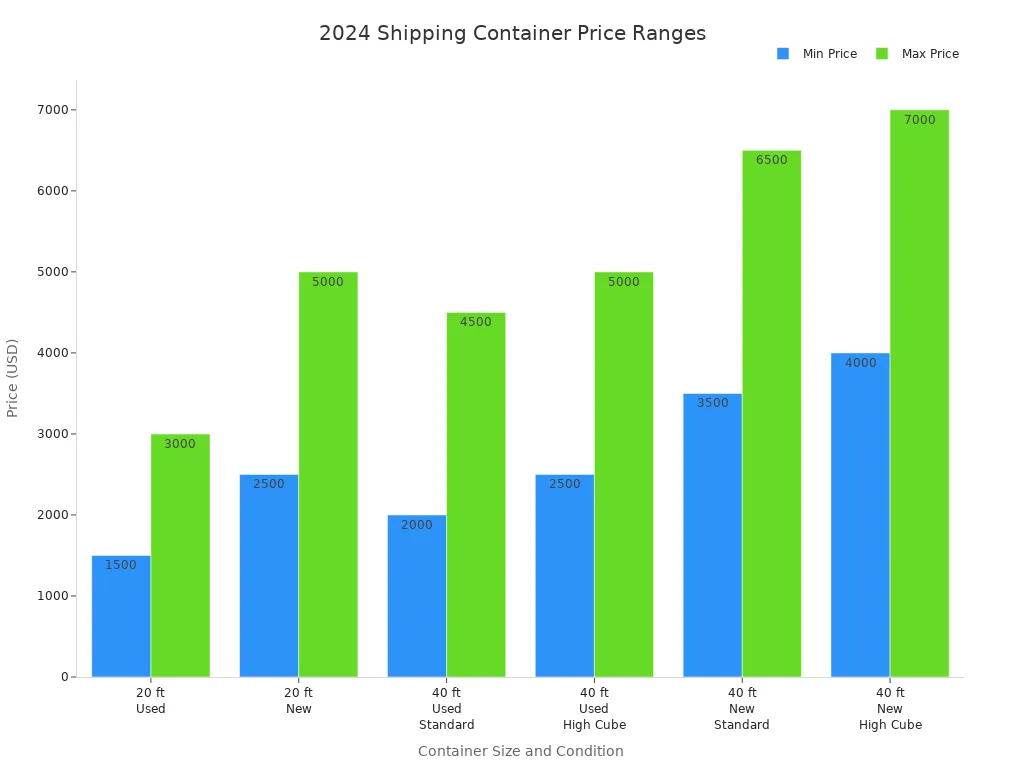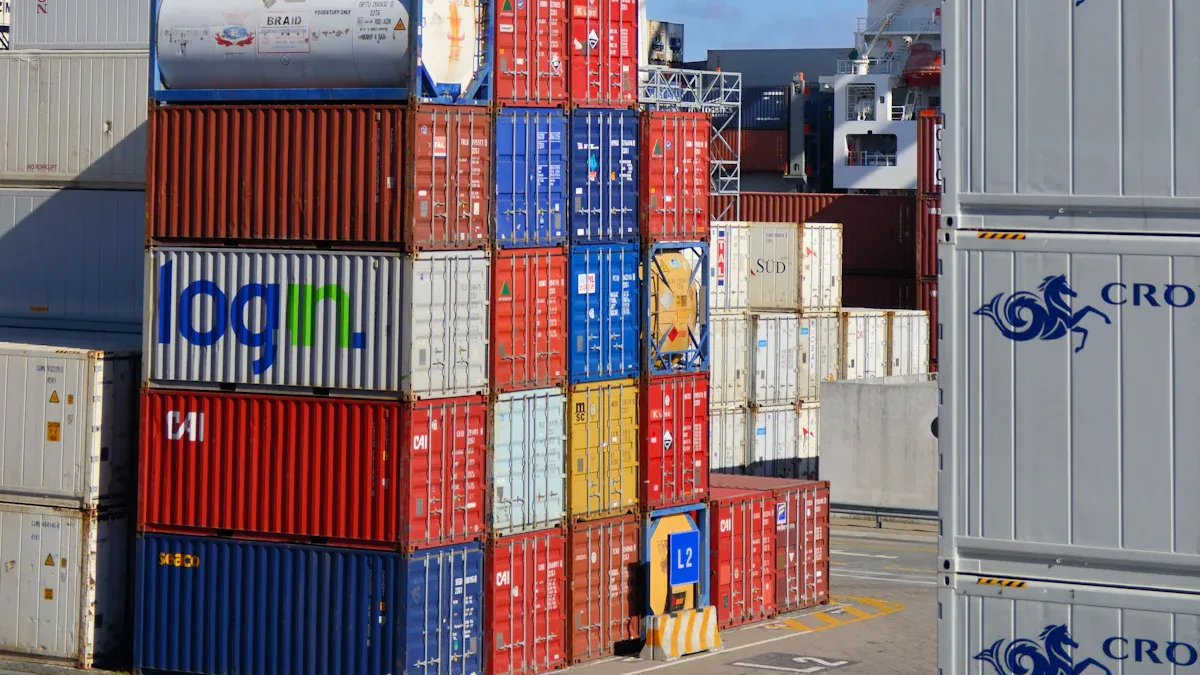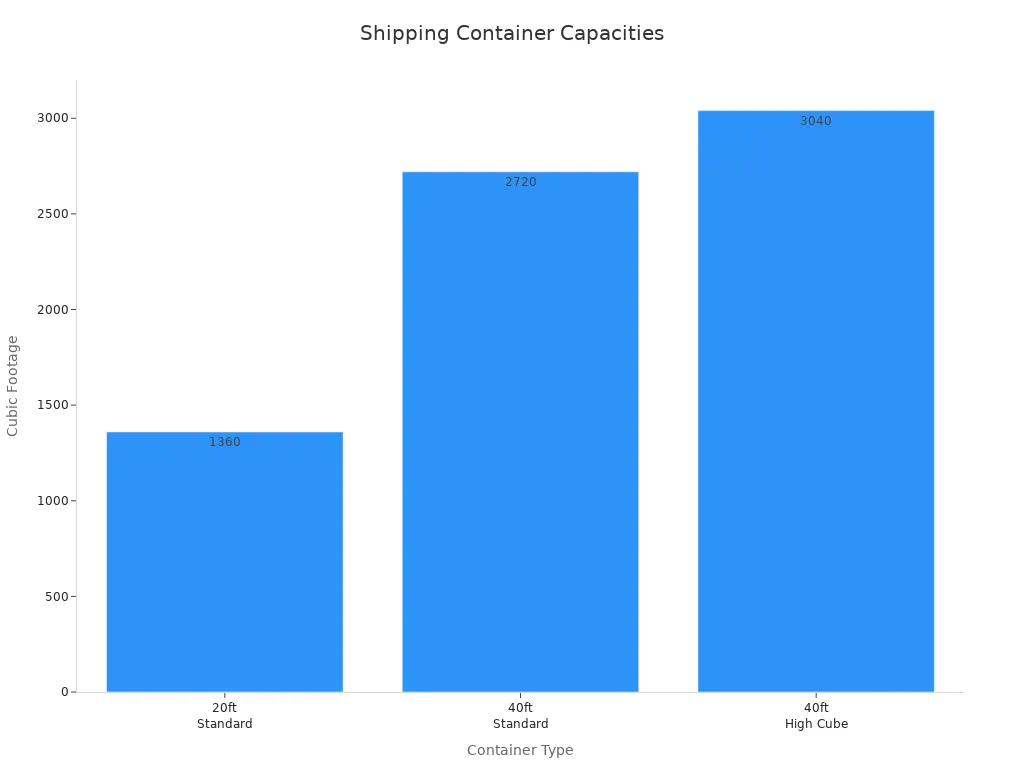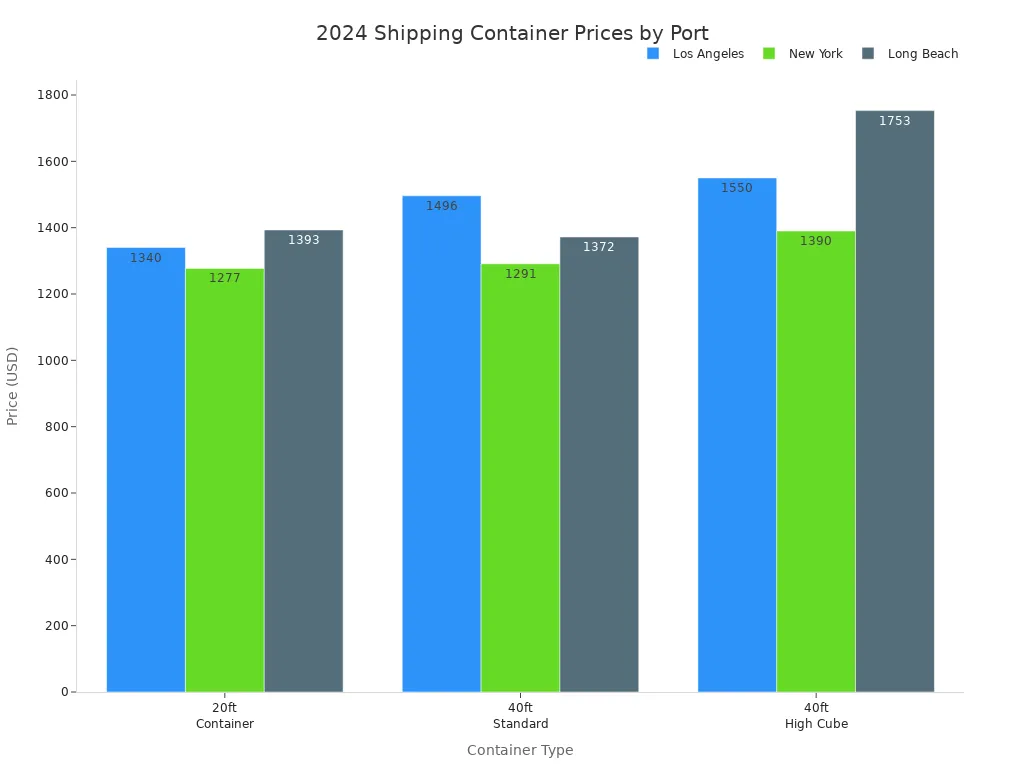

Views: 0 Author: Site Editor Publish Time: 2025-06-18 Origin: Site








Container Type | Size | Condition | Average Price Range (USD) |
|---|---|---|---|
Shipping Container | 20 ft | Used | $1,500 - $3,000 |
Shipping Container | 20 ft | New | $2,500 - $5,000 |
Shipping Container | 40 ft | Used | $2,000 - $5,000 |
Shipping Container | 40 ft | New | $3,500 - $7,000 |

Prices can change because of market demand, steel prices, and changes like adding refrigeration or turning it into an office. You can save money by picking the right shipping container for what you need. If you want to know how much a storage container costs for your business, you can work with a freight forwarder like Youda. They can help you get better prices and good door-to-door service.
Shipping container prices change based on size, condition, and where you buy them. Used 20-foot containers start at about $1,500. New 40-foot high cubes can cost up to $7,000. Picking the right size and condition helps you save money. Smaller or used containers are cheaper. High cube and new containers cost more. Prices also change because of supply and demand. Where you live and the time of year matter too. Buying near ports or in slow months can lower costs. Adding things like refrigeration or insulation makes containers cost more. Plan these changes so you do not spend too much. Working with a trusted freight forwarder like Youda is helpful. They give good price quotes and help you avoid extra fees. They also make sure delivery and paperwork go smoothly.

When you look at shipping container prices, you need to think about three main things: size, condition, and market factors. Each of these can change the price you pay and the total shipping container cost for your business.
Shipping containers come in different sizes. The most common are 20-foot, 40-foot, and 40-foot high cube containers. The shipping container size you choose will affect both the price and how much cargo you can move. Here is a table showing the standard dimensions and capacities:
Container Type | External Dimensions (ft) | Internal Dimensions (ft) | Usable Volume (ft⊃3;) | Max Gross Weight (lbs) |
|---|---|---|---|---|
20ft Standard | 20' x 8' x 8'6" | 19'5" x 7'8" x 7'9" | 1,360 | 52,910 |
40ft Standard | 40' x 8' x 8'6" | 39' x 7'8" x 7'9" | 2,720 | 67,200 |
40ft High Cube | 40' x 8' x 9'6" | 39' x 7'8" x 8'9" | 3,040 | 67,200 |
A 20-foot container is usually the most affordable. A 40-foot container gives you double the space, so the price is higher. High cube containers offer extra height, which means more volume and a higher cost. This pattern holds true in most regions. For example, in Los Angeles, a used 20-foot container costs about $1,340, while a 40-foot high cube can reach $1,753.

The shipping container condition also plays a big role in the final price. You can choose from several categories:
Brand New: These containers have only made one trip from the factory. They look almost perfect and have the highest price.
Excellent Condition: These meet strict standards and are good for shipping. They may have minor wear.
Cargo Worthy: These are strong and safe for shipping but show more signs of use.
Wind and Watertight (WWT): These keep out wind and water but may have rust or dents. They work well for storage.
As-Is: These may have damage or holes. They are the cheapest but may need repairs.
The price drops as the condition goes down. For example, a new shipping container can cost 60-80% more than a used shipping container. Here is a table showing how condition affects price in Chicago:
Container Type | Brand New (USD) | Excellent (USD) | Cargo Worthy (USD) | Wind & Watertight (USD) | As-Is (USD) |
|---|---|---|---|---|---|
20-foot standard | $1,800 | $1,300 | $900 | $975 | $700 |
40-foot standard | $3,400 | $1,750 | $1,000 | $1,300 | $1,300 |
40-foot high cube | $2,900 | $1,900 | $900 | $1,050 | $1,150 |
Tip: If you only need storage, you can save money by choosing wind and watertight or as-is containers.
Shipping container prices change because of many outside factors. Supply and demand, global events, and even the time of year can all affect the price you pay.
Supply and Demand: When more people need containers, prices go up. When there are too many containers, prices drop.
Regional Differences: Containers cost less in port cities like Los Angeles or New York. Inland areas have higher prices because of delivery costs.
Economic Trends: Inflation, fuel prices, and trade policies can raise the cost of containers. For example, tariffs on imported containers from China and Vietnam have made new containers more expensive in the US.
Seasonal Changes: Prices often rise from August to November because of holiday shipping. You may find better deals from January to March, when demand is lower.
Global Disruptions: Events like the Red Sea crisis or port congestion can cause prices to spike quickly.
Here is a table showing recent price trends in major US cities:
Container Type | Los Angeles Price (USD) | New York Price (USD) | Long Beach Price (USD) |
|---|---|---|---|
20ft Container | 1,340 | 1,277 | 1,393 |
40ft Standard Container | 1,496 | 1,291 | 1,372 |
40ft High Cube | 1,550 | 1,390 | 1,753 |

Note: International regulations and tariffs can also impact shipping container cost. In 2025, new tariffs increased the price of imported containers, making used containers in the US more popular.
Shipping container prices remain higher than before the pandemic. Global trade, fuel costs, and supply chain disruptions keep prices elevated. If you want to control your shipping container cost, consider working with a trusted freight forwarder like Youda. Youda offers sea freight, door-to-door service, and custom logistics solutions to help you get the best value. You can learn more about their services at Youda Sea Freight.

When you think about shipping container cost, there is more than just the price tag. Three big things can change what you pay: location, modifications, and delivery. Knowing about these things helps you plan your money and not get surprised.
Where you buy or get your shipping container changes the price. If you live close to a big port city, you will pay less. Cities like Los Angeles or New York have lots of containers and big storage places, so prices are lower. But if you live far from the coast or in a small city like Phoenix or Denver, prices go up. This is because it costs more to move containers there and there are not as many. The table below shows how where you live changes the price:
Geographic Location | Pricing Influence | Explanation |
|---|---|---|
Major Port Cities | Lower prices | High volume and economies of scale reduce costs. |
Inland/Remote Areas | Higher prices | Scarcity and higher delivery costs increase the shipping container cost. |
Midwest Cities | $200-$500 higher | Extra transport needed; containers stay near major hubs like Chicago. |
Texas/Florida | Variable | Popular terminals lower cost, but remote areas see higher prices. |
Tip: To save money, try to buy your container near a port or big city.
You can change a shipping container to fit what you need, but every change costs more. People often add windows, doors, better floors, electricity, or air conditioning. These changes make containers good for offices, stores, or homes. Some special things, like making it cold inside, can cost a lot more. For example, adding a refrigerated unit can make the price go up by $4,000 to $18,000. The table below shows how much some changes can cost:
Feature / Modification | Additional Cost Range (USD) |
|---|---|
Refrigerated Unit | $4,000 - $18,000 |
Mini-Split AC Unit | $2,000 - $3,000 |
Spray Foam Insulation | $2,000 - $4,000 |
Custom Doors, Electrical, Flooring | Several thousand dollars |
Fully Outfitted Climate Control | $14,000 - $18,000 |
Note: The price of a shipping container goes up fast if you add special features or custom changes.
How much it costs to deliver your shipping container is also important. If you live far from a port, you will pay more. Delivery price depends on how far it goes, how big and heavy it is, and how easy it is to drop off. Moving a container less than 200 miles can cost $600 to $1,200. If it has to go farther or the place is hard to reach, it costs more. You might also pay extra for cranes, special trucks, or waiting at the port. If you ship it to another country, you pay customs, port fees, and it can take longer.
Average cost per mile in the US is $1.00–$4.00
Short trips under 200 miles cost $600–$1,200
Loading or unloading can cost $1,200–$2,500
Using a crane costs $1,500–$4,000 each time
Pro Tip: Work with a trusted freight forwarder like Youda. They give clear prices and help with sea freight or door-to-door delivery. This helps you know the real cost and not get extra fees.
If you know about these shipping container price factors, you can guess your total cost better and make smart choices for your business.
Getting a good quote helps you know the real cost. This way, you will not be surprised by extra charges. You want the best price and service for what you need. Here are some steps you can use:
You should look at different sellers before you buy. Each seller may have a different price or delivery plan. Some sellers offer better service than others. Try both online marketplaces and local dealers to see your options. The table below shows how they are different:
Aspect | Online Marketplaces | Local Dealers |
|---|---|---|
Pricing | Platform fees, global prices | Often lower, especially for used containers |
Shipping | Integrated, global shipping | Local delivery, lower cost |
Service | Broad selection, online support | Personalized, in-person inspection |
Customization | Bulk discounts, some customization | Limited customization |
Buyer Experience | Compare sellers easily | Face-to-face, faster transactions |
Tip: Always ask for a full list of costs. Check if there are delivery fees, taxes, or hidden charges. Look at payment rules and return policies. This helps you avoid surprise costs and get the right price.
Asking good questions helps you get a clear quote. Here are some important things to ask:
What is the total cost, including delivery and taxes?
Can I see the container before I buy it?
What is the condition of the container?
Do you offer any changes or custom features?
How do you deliver and how long does it take?
What papers or certificates come with the container?
What are your payment choices and warranty rules?
Note: Ask for certificates like CSC, ACEP, and ISO. If you buy used, ask for repair records. This helps you get the right price and a safe container.
A freight forwarder like Youda can help you get the best quote. They check prices from many companies and handle all the details. Youda offers sea freight, air freight, and door-to-door service. Their team helps with papers, customs, and insurance. You get help at every step, so you do not pay extra or wait too long.
Working with a freight forwarder saves you time and money. You get the right price, safe delivery, and less stress. Visit Youda Sea Freight to learn more or ask for a quote today.
You have to think about many things that change the total cost. These include container price, transportation, maintenance, and insurance. Experts say you should look at size, type, distance, and supply first. Always check sellers, compare prices, and look for hidden fees.
If you work with a trusted freight forwarder like Youda, you can save money and avoid delays. They take care of sea freight, air freight, and all the planning. This makes everything easier for you. Make sure you get clear quotes and read all the details before you buy.
Think about how much stuff you need to move or store. A 20-foot container is good for smaller shipments. If you have more things, pick a 40-foot or high cube container. Youda can help you find the best size for your sea freight or door-to-door delivery.
The total cost includes the price of the container, delivery, and any changes you want. You might also pay for customs, insurance, and unloading. Always ask Youda for a full quote so you do not get surprise fees.
Yes, you can use containers for storage, offices, or homes. Many people add things like insulation, doors, or windows. Youda has custom options for different uses, like warehouses or distribution.
Delivery time depends on where you live and how it ships. Local delivery can take just a few days. Shipping by sea to another country can take weeks. Youda ships fast and keeps you updated during the whole process.
A freight forwarder helps with every step of the process. They handle paperwork, customs, and planning. Youda gives you complete solutions, which saves you time and money. Visit Youda Sea Freight to learn more.